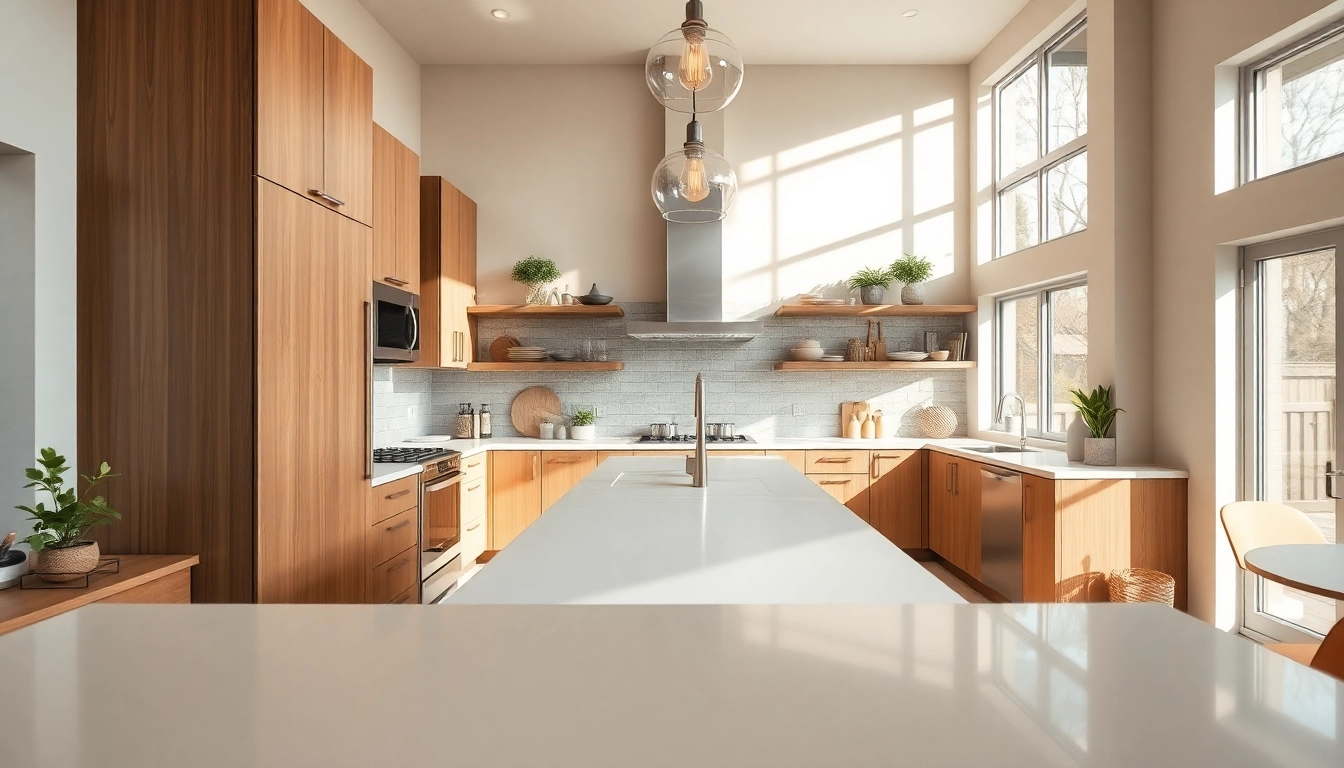Embarking on a kitchen remodel can be an exhilarating yet daunting task for homeowners. It’s a chance to enhance not only the aesthetics of one of the most frequented spaces in the home but also its functionality and overall efficiency. This article will delve into various aspects of kitchen remodels, providing you with insights, tips, and a roadmap to navigate your remodeling journey successfully.
Understanding Kitchen Remodels
What is a Kitchen Remodel?
A kitchen remodel involves renovating or updating the kitchen’s structure, style, and functionality. This can include anything from a simple cosmetic update, like painting cabinets or replacing countertops, to a significant overhaul that may involve relocating plumbing, electrical systems, or structural elements. At its core, a kitchen remodel aims to make the space more beautiful and more efficient, addressing both style and usability to meet the homeowner’s lifestyle.
Benefits of Remodeling Your Kitchen
There are numerous benefits associated with remodeling your kitchen. Here are some key advantages:
- Increased Home Value: A well-executed kitchen remodel can significantly enhance your home’s market value. According to the National Association of Realtors, kitchens often yield a high return on investment (ROI) during resale.
- Improved Functionality: A remodel can address key functional aspects of the kitchen, such as storage needs and workspace efficiency. Adjusting the layout can create a more cohesive and user-friendly environment.
- Modernization: Older kitchens may lack modern conveniences such as energy-efficient appliances or contemporary design trends. A remodel allows homeowners to embrace the latest designs and technologies.
- Enhanced Aesthetics: One of the most immediate benefits of remodeling is the aesthetic uplift. A fresh design can significantly improve your enjoyment of the space.
Common Myths about Kitchen Remodels
Despite numerous success stories, several myths about kitchen remodeling can deter homeowners:
- Myth 1: Remodeling is Always Expensive: While costs can accumulate, numerous budget-friendly remodeling strategies can be employed. Careful planning will help keep expenses in check.
- Myth 2: You Need to Start from Scratch: Many kitchen renovations focus on changing specific elements without a complete overhaul. Retrofits and updates to existing structures can yield transformative results.
- Myth 3: DIY is Always Cheaper: Although DIY can save money, hiring professionals can sometimes be more cost-effective in terms of quality and longevity.
Setting a Budget for Your Kitchen Remodel
How to Estimate Your Budget
Estimating a budget is a critical first step in any kitchen remodeling project. Follow these steps to create a realistic budget:
- Define Your Scope: Determine the extent of changes you want—cosmetic updates, a major remodel, or new appliances. This will significantly influence your budget.
- Research Costs: Investigate the average costs of materials, labor, and appliances in your area. Websites like HomeAdvisor can provide valuable insights.
- Include Contingencies: Plan for unexpected expenses—typically about 10-20% of your total budget. This cushion will help you handle surprises without distress.
Factors Influencing Kitchen Remodel Costs
Several factors can influence the overall cost of your kitchen remodel:
- Size of the Kitchen: Larger spaces will naturally incur higher expenses.
- Material Choices: High-end materials such as granite and custom cabinets will drive up costs compared to laminate products.
- Labor Costs: Hiring experienced professionals can vary significantly based on geographical area and complexity of work.
- Appliance Upgrades: Energy-efficient and larger appliances will increase initial costs but can save on utility bills in the long run.
Cost-Effective Ideas for Budget-Friendly Remodels
If you’re working with a limited budget, here are some cost-effective strategies to consider:
- Refresh Cabinets: Instead of replacing cabinets, consider repainting or refinishing them for a fresh look.
- Smart Storage Solutions: Utilizing space-saving inserts and organizers can help maximize your existing kitchen layout without drastically modifying it.
- Focus on Lighting: Upgrading lighting fixtures can transform the space significantly without substantial expenditures.
- Don’t Ignore Small Details: New hardware and faucets can breathe new life into older designs at a lower cost.
Choosing the Right Design Style
Popular Kitchen Design Styles Overview
Choosing a kitchen style involves looking at various design elements and how they can harmonize with your home. Popular kitchen design styles include:
- Modern: Emphasizing sleek lines, minimalism, and functionality, modern kitchens often feature open layouts and stainless steel appliances.
- Traditional: Rich woods, classic cabinetry, and ornate decor characterize traditional kitchens, creating a warm and inviting atmosphere.
- Farmhouse: This style combines rustic charm with modern convenience, often featuring open shelving, farmhouse sinks, and natural materials.
- Contemporary: Similar to modern design with a bit more flexibility, contemporary kitchens incorporate the latest trends and materials for a fresh appeal.
Combining Functionality with Aesthetics
Effective kitchen design blends beauty with practicality. Consider the following:
- Work Zones: Identify key work zones (cooking, cleaning, prep) and plan workflows accordingly. A common design principle is the “work triangle”, ensuring efficient movement between the sink, refrigerator, and stove.
- Lighting: Ensure adequate task lighting in work areas while also adding ambient lighting for warmth and style.
- Durable Surfaces: Choose materials that withstand daily wear and tear while being easy to clean.
Color Trends in Kitchen Remodels
The color palette of your kitchen can greatly influence the space’s vibe and emotion.
- Bold Colors: Bright colors, such as teal or yellow, can energize the kitchen, but consider using them as accents rather than primary tones.
- Neutral Tones: Whites, greys, and earth tones remain a timeless choice, providing a serene backdrop that can complement various design elements.
- Contrasting Elements: Pairing light cabinets with dark countertops or vice versa can create a striking visual appeal.
Selecting Materials and Finishes
Durable Countertop Options
Selecting the right countertop materials is essential, both for the aesthetic appeal and functional durability of your kitchen. Popular options include:
- Granite: Popular for its durability and natural beauty, each slab is unique.
- Quartz: Man-made and available in various colors and patterns, quartz is non-porous and extremely durable.
- Butcher Block: Ideal for cooking enthusiasts, butcher block provides a warm, inviting look and is easily replaceable.
- Laminate: An economical choice available in numerous designs, laminate has evolved significantly, mimicking more expensive materials.
Cabinet Choices: Materials and Styles
Your cabinet choice has a significant influence on the overall feel of your kitchen. Consider these aspects when choosing cabinetry:
- Material: Solid wood cabinets offer longevity, while MDF and plywood can provide budget-friendly alternatives.
- Finish: High-gloss finishes can create a modern look, while painted or stained finishes add warmth and character.
- Style: Think of the door style—shaker, raised panel, or flat paneled—this will shape the aesthetic of the kitchen significantly.
Flooring Options for Timeless Appeal
The right flooring can elevate your kitchen’s design and functionality. Consider these flooring options:
- Hardwood: Offers a warm aesthetic and longevity, but requires maintenance.
- Tile: Versatile and available in various styles, tile is durable and easy to clean.
- Vinyl: An economical choice that mimics more expensive materials, with ease of installation and maintenance.
- Laminate: Budget-friendly and available in a variety of finishes, laminate flooring mimics wood or stone at a lower cost.
Executing a Successful Remodel
Hiring Professional Help vs. DIY
Deciding between DIY and hiring professionals comes down to the scale of the project and your comfort level with home renovations. Weigh the pros and cons of each:
- Hiring Professionals: They bring experience and expertise, ensuring that your remodel meets codes and regulations while minimizing costly errors.
- DIY: This can save costs; however, be honest about your skill level and the complexity of the project. Some tasks might be better left to professionals for safety or structural reasons.
Planning the Remodeling Process
Having a clear plan in place will be crucial to navigating your remodel effectively. Here’s how to structure your approach:
- Establish a Timeline: Determine a realistic timeline from the initial design phase through completion.
- Obtain Necessary Permits: Research any local regulations that require special permits for plumbing, electrical, or structural work.
- Communication: If working with contractors, ensure consistent communication to keep the project aligned with your expectations.
Dealing with Common Remodeling Challenges
Even with thorough planning, challenges may arise during your remodel. Here are some common challenges and solutions:
- Budget Overruns: Be proactive in tracking expenses and stick to your budget. If changes are necessary, evaluate them against your overall plan for their impact.
- Delays: These can happen for a variety of reasons, including delayed materials or labor issues. Keeping a flexible timeline will help mitigate stress.
- Design Discrepancies: Ensure that every design choice is confirmed and that contractors understand your vision to avoid miscommunications.
In conclusion, a kitchen remodel is a complex but rewarding project that can significantly enhance your home’s functionality and aesthetic appeal. By understanding the elements involved and planning meticulously, you can create a space that suits your style, needs, and budget—all while increasing the value of your home. Remember, the key is to stay informed, be organized, and choose a design that resonates with your personal style and practical requirements.


